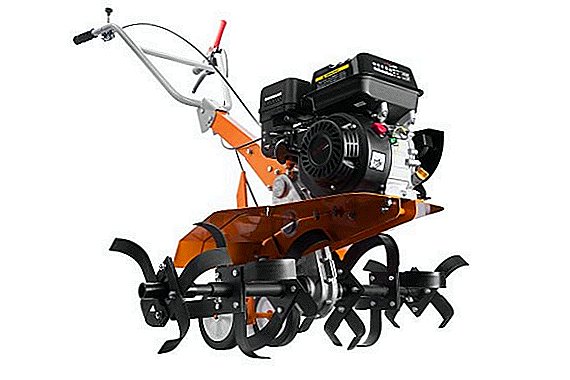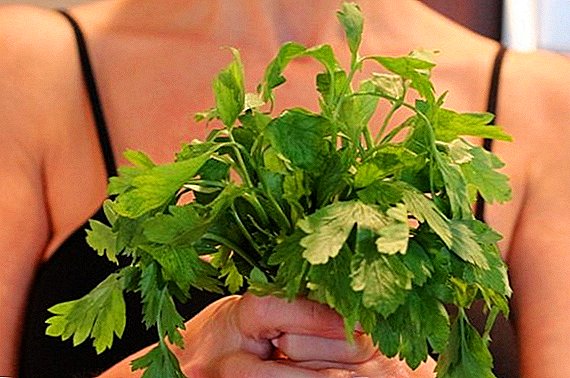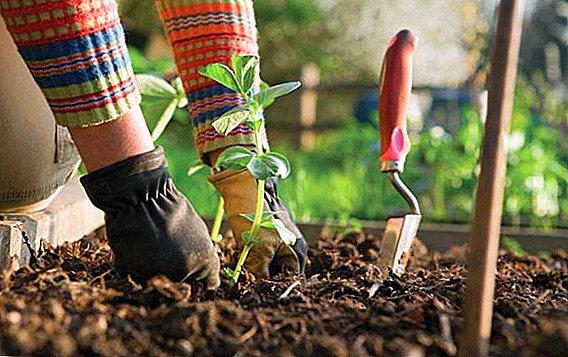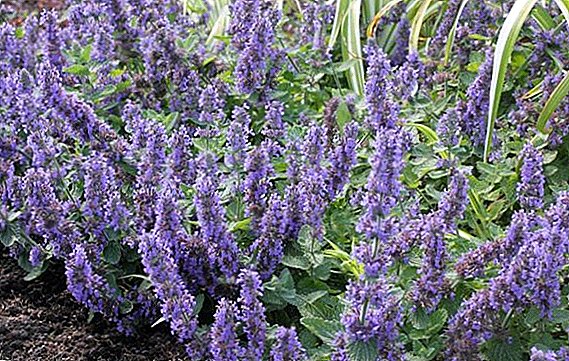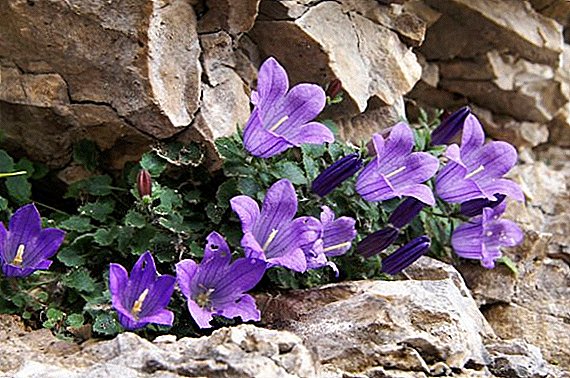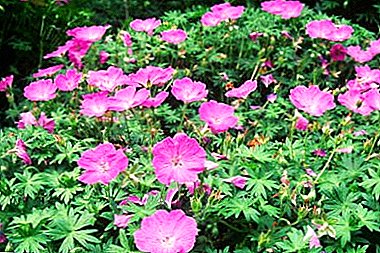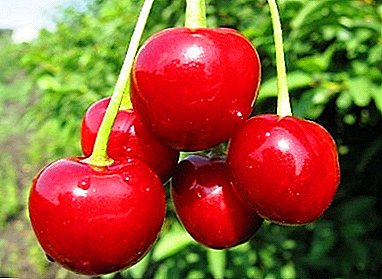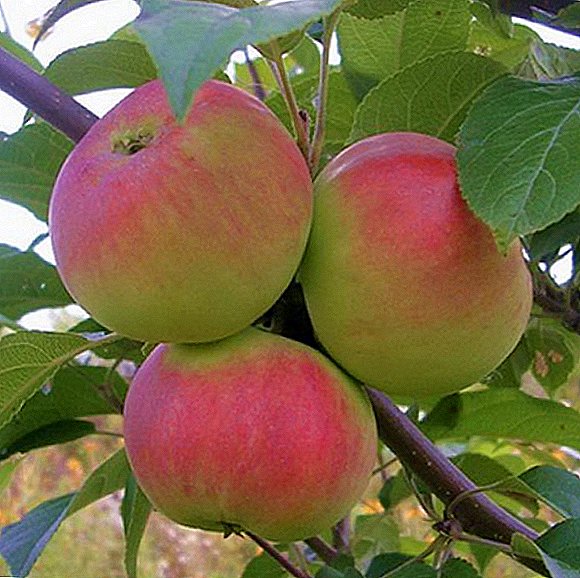 Many gardeners want to see consistently fruit-bearing apples with fruits of universal use that can be stored in winter. These qualities have a variety of Siberian breeding "Gift to gardeners."
Many gardeners want to see consistently fruit-bearing apples with fruits of universal use that can be stored in winter. These qualities have a variety of Siberian breeding "Gift to gardeners."
Breeding history
This variety was bred in the city of Barnaul in 1959 by the Research Institute of Horticulture named after Lisavenko MA. when crossing the autumn winter-resistant high-yielding variety "Laletino" and the late-summer variety of the Canadian apple tree "Melba", which has high taste qualities.
The result is a fast-fruited autumn variety, which is resistant to frost and some diseases, and has delicious lying apples.
The creators of the variety "Gift to gardeners" became L.Yu. Zhebrovskaya, I.P. Kalinina, T.F. Kornienko, N.I. Dorokhina, G.V. Chupin. Received very widespread in areas of western Siberia and Altai, but successfully grown in many other regions.
Biological features
According to the description of the variety, the advantages of the apple tree "Gift to the Gardener" are rather high precociousness, winter resistance, relative resistance to scab and the wonderful taste and quality of apples.  The disadvantages of this variety include its poor tolerance to drought, and besides, with very severe frosts, the tree can still freeze.
The disadvantages of this variety include its poor tolerance to drought, and besides, with very severe frosts, the tree can still freeze.
Description of the tree and the best pollinators
This is a medium-sized tree, the height of which is not more than three meters. It forms a rounded crown of medium thickness with often short-growing red-brown branches that have many annuli, fruits and a spear for the formation of fruits.
Winter-hardy are also such varieties of apples: "Moscow pear", "Cinnamon striped", "Silver hoof", "Antey", "Medunitsa", "Orlov" and "Ural bulk".Straight-growing shoots have an average thickness, brown color, have a small edge and a rounded shape of the saw cut. Elongated leaves with a short spike at the ends, long petioles and lanceolate stipules. They have an average size, grayish color and barely noticeable pile from the bottom of the sheet.
The apple variety "Gift to the gardener" is self-fertile and this is another advantage. It does not need insect pollinators, it shows itself well in single plantings. 
Fruit Description
Fruits of the small sizes ripen in the middle-end of September, universal use. That is, go for canning, juice, drying and storage. They can be stored for up to four months.
Apples of this variety are of medium size, their weight is 60-100 grams. Rounded, slightly flattened fruits have a smooth wax-skin of yellow-green tones, mostly covered with red strokes. These reddish touches give the apples a ruddy look.
Inside, they have white, with a light green tinge flesh, fine-grained, dense. Juicy fruits have a pleasant aroma and a wonderful sweet-sour taste. According to the tasting 5-point scale, the taste of the variety "Gift to the Gardener" is estimated at between 4.5 and 4.8.
The sugar content of apples is 13.3%. In addition to sugars, 100 grams of pulp contain the following substances:
- Pectins - 5.30%;
- Titrated acids - 1.22%;
- P-active substances - 300 mg;
- Tannins - 60 mg;
- Vitamin C - 25 mg.

Yield
This is a medium-yielding variety. The first harvest from an apple tree can be harvested in the third or fourth year, approximately in the middle of September, but this variety gives its maximum amount of fruits (30 kilograms from a tree) not earlier than the sixth year after planting.
For horticultural farms, the yield index is 125 centners per hectare. With proper agrotechnics, the yield is stable, annual due to self-fertility and winter resistance of the variety.
How to choose seedlings when buying
Usually, apple seedlings are planted in the ground in spring and autumn. It is best to buy them no earlier than a week before landing. It is advisable to buy in local nurseries or in places with the same climatic conditions.
When choosing a sapling, focus your attention on the following:
- it is better to choose young saplings (1 or 2 years) - they take root more easily;
- the root system should look sufficiently developed, the roots are healthy, without rot and growths;
- do not buy plants that look sluggish, dried up, it is desirable that they have traces of the substrate or earthy lump;
- the crust must be smooth and free from damage;
- It is advisable to buy a seedling with non-budding buds. The seedling that released the buds is no longer suitable for planting.
 Freshly purchased seedlings before planting should be put in water for several hours.
Freshly purchased seedlings before planting should be put in water for several hours.How to plant an apple tree on the plot
This unpretentious variety has high restorative abilities, but it should be planted properly.
Optimal timing
Young apple trees can be planted in the ground in early spring (March-April) or in the middle of autumn (October), depending on the climatic zone and weather conditions.
Did you know? The story of the "golden apples", which grant those who got them and ate, eternal youth, is found in the tales of almost all the peoples of Western Europe.Gardeners usually plant trees in the fall, as this leaves a lot of time for the adaptation and preparation for the growing season, and in the spring there is so much trouble. It is recommended to plant trees in spring only in places with dry and cold autumn.
Selection and preparation of the site
The choice of landing site plays a very important role. It is best to choose a sunny place without drafts where the trees did not grow earlier or the soil rested for a year or two after uprooting and recovered.  If it is impossible to find such a place, then the soil completely changes in the pit for planting. Groundwater should not lie closer than 1-1.5 meters, otherwise it will be necessary to make an embankment to prevent rotting of the roots.
If it is impossible to find such a place, then the soil completely changes in the pit for planting. Groundwater should not lie closer than 1-1.5 meters, otherwise it will be necessary to make an embankment to prevent rotting of the roots.
If there are slopes in southern places with warm winters and hot summers, you need to plant apples on the northern slope, and in northern areas with frosty winters and cool summers, choose the southern sides. Apple trees do not like stony ground or soil with rubble, they prefer loam.
Important! According to the Charter of the Ukrainian Horticultural Society, srednerosly trees are planted two meters from the bed, tall trees - three meters, shrubs - one meter.Planting pits can be pre-dug for 1-4 weeks before the purchase of seedlings, while the top layer is thrown away from the bottom. They dig a hole about one meter wide and 60-80 cm deep.
The planting pit will supply the tree with nutrients over the coming years, so the fertile top layer of the soil from the dug pit is mixed with humus, peat or compost, manure.  For planting it is recommended to prepare additives from ash and mineral fertilizers (superphosphate). If the area is clay soils, then the soil mix is mixed with sand. When sandy - form a moisture retaining layer from clay.
For planting it is recommended to prepare additives from ash and mineral fertilizers (superphosphate). If the area is clay soils, then the soil mix is mixed with sand. When sandy - form a moisture retaining layer from clay.
Process and scheme
The distance between the trunks of medium trees should be from 3.5 to 4 meters. When an apple tree in the garden is one, the other trees or shrubs should grow no closer than three or four meters.
When landing in a pit about one-third of its depth, prepared soil mixture is mixed with the addition of ash (250 ml) and 200-300 grams of superphosphate. A seedling with a planting peg is carefully placed in the pit, the roots are gently straightened and the soil mix is poured to the root collar.
Did you know? The Celts called paradise Avalon, which means "the land of apples."A sapling is tied to a prepared peg. Condense, form the near-stem circle, water, and make sure that the root neck rises 5-6 cm above the soil. The hole around the tree is mulched about 5 cm with a suitable material (humus, peat, straw, leaves, tops, etc.).
Seasonal care features
At first the young seedling needs to be watered well. In the following years, caring for an apple tree consists of caring for the soil and timely watering, necessary dressings, treatment against pests and diseases, crown formation and protection from frost and rodents.
Soil care
Young seedlings are watered when the soil dries in the hole around the apple tree. More mature trees are watered from spring to almost the first frost.
Normal watering time:
- a few days before flowering;
- when the excess ovary subsides;
- during the filling of the fruit;
- after leaf fall.
Important! The amount of water for irrigation depends on the age of the tree. For an apple tree the first two years of life, 4-5 buckets of water are sufficient, but for an already fruiting tree, the irrigation rate is 7-10 buckets.
 The soil of the okolostvolnogo circle should always be mulched - it will protect it from overheating, allow it to retain moisture, improve the quality of the land and eliminate weeding.
The soil of the okolostvolnogo circle should always be mulched - it will protect it from overheating, allow it to retain moisture, improve the quality of the land and eliminate weeding.
Therefore, in early spring, having dug deep near the trunk, you need to lay a layer of mulch. It should not be used as mulch under the apple tree lapnik, sawdust, shavings and bark of coniferous trees, as they can change the acidity of the soil.
The grass between the rows mowed or planted a mixture of the following herbs:
- meadow fescue;
- meadow grass;
- red fescue;
- grazing ryegrass.
Top dressing
The yield of any fruit tree depends on the supplements applied under it. In the first two years in early spring, young saplings fertilize first with mullein infusion, and in May-June they make foliar feeding from complex fertilizers.
At the beginning of flowering, a bucket of organic fertilizers (compost or humus) is brought under the sapling tree and the ground is mulched.  In subsequent seasons, together with the spring contribution of organic matter, they carry out autumn dressing with phosphorus-potassium mineral fertilizers and introduce ash.
In subsequent seasons, together with the spring contribution of organic matter, they carry out autumn dressing with phosphorus-potassium mineral fertilizers and introduce ash.
To do this, during digging in the fall, 30 grams of potassium sulphate and double superphosphate, a glass of ash are introduced under the tree.
Important! It is not recommended to get involved in feeding apples with nitrogen fertilizers, as overfeeding them reduces the resistance of trees to frost and reduces the shelf life of the fruit.Young apples in the years without fruiting make two foliar feeding, sprinkling it with urea (35 grams per 10-liter bucket of water). This treatment is done immediately after flowering and in a month.
Preventive treatment
This variety is relatively resistant to scab, but in rainy periods it can still be affected by powdery mildew. There is a chance of getting a bacterial burn that cannot be cured, then a sick apple tree will need to be uprooted and burned.
Insect pests can also cause significant damage to crops. The apple tree may be affected by the fungus with a tinder, which must be disposed of as soon as it is found on the trunk (cut and cover the wound with copper sulphate and garden pitch).  Timely preventive treatment will save the tree from many diseases and pests. It usually consists of the following measures:
Timely preventive treatment will save the tree from many diseases and pests. It usually consists of the following measures:
- making the necessary dressings;
- correct crown formation;
- spraying gray and copper sulphate.
Cropping and crown formation
When caring for an apple orchard, such works as pruning branches and crown formation are required. These garden works contribute to an earlier fruiting of apple trees, increase in yield, increase in life expectancy and provide additional protection against cold. Pruning done in spring or autumn.
The first time pruning is carried out at the beginning of spring a year after planting the seedling in the ground. Thin branches are cut with a secateur, and thicker ones with a saw. The cuts of the branches are disinfected using a solution of copper sulphate, and then subjected to a special putty treatment, called garden pitch. In this case, the old branches are processed by the bar immediately, and the young - the next day. During the planting of a young sapling, apple trees shorten the main shoot, the tree is not pruned from one to three years, only dry and broken shoots are cut.
The apple tree grows and a lot of branches appear on it, they are cut about two thirds of the entire length. The buds on the branches that remain should not be turned towards the crown.
There are branches, in which the buds are located on the outside, and those located inside the crown are removed, as they thicken it. In spring, branches frozen in winter, diseased and broken shoots are pruned, the crown is thinned out for a more free flow of sunlight and air.
Pruning is done in autumn from September to November before the onset of severe frosts. Young saplings pruned a little over the summer shoots. Trees that are more than five years old, cut sturdier shoots by a third.
If the apple has a small increase, then it needs intensive pruning. Autumn pruning includes the removal of dry, weak, broken shoots growing inside the crown, as well as branches that grow from the crown or main branch at a too acute angle.  With the help of pruning apple branches is the formation of apple crown. For the medium variety “Gift to gardeners”, the most common pruning scheme - sparsely-tiered is suitable. On the trunk of the apple leaves three or four skeletal branches, located in the form of a tier.
With the help of pruning apple branches is the formation of apple crown. For the medium variety “Gift to gardeners”, the most common pruning scheme - sparsely-tiered is suitable. On the trunk of the apple leaves three or four skeletal branches, located in the form of a tier.
On the tier below, no more than two shoots are left at a distance of 40 to 60 cm from each other. If the young tree does not grow, then the top of it will be cut off approximately 0.5 meters. With this formation, the branches crown are arranged in tiers and the crown is similar to the natural shape of an apple tree.
Protection against cold and rodents
Apple trees are recommended to be sheltered from frost, when the cold is around -10 ° C. Too early a sheltered tree can wake up in the winter and release buds, which can lead to its death in subsequent frost.
Learn how to shelter an apple tree for the winter from frost and rodents.Apple tree trunks can be covered with various insulating materials: agrofibre, roofing felt, special film, reed, spruce branches. Such protection will also not allow rodents to the tree, because in winter an apple tree can be severely damaged by mice, rats, and hares.
 Pristvolny circle for the winter is good cover with a thick layer of mulch. When a sufficient amount of snow falls, you need to move it under the tree more and periodically pour it so that the apple tree should always be covered by it.
Pristvolny circle for the winter is good cover with a thick layer of mulch. When a sufficient amount of snow falls, you need to move it under the tree more and periodically pour it so that the apple tree should always be covered by it.Young seedlings can be completely covered with snow. When it gets warmer, do not rush to open the trunk, because strong frosts may return in spring.
Important! It is not necessary to protect apple seedlings from frost in the southern regions, as this can wake up the growing season of the tree at an inopportune time and cause its death.Do not rush to uproot the frozen tree. If the apple tree has preserved the roots and lower branches, then one can form a crown in the stannale form and reap the harvest after three years. In southern areas, the trunk of rodents is wrapped with a special net.
With the attentive care of the relatively unpretentious apple varieties "Gift to gardeners", in the fall gardeners will get a wonderful harvest of apples, which is stored for a long time. After all, apples are not only a common fruit for cooking, but also a source of antioxidants, vitamin C, A, iron, potassium, calcium, sodium, magnesium, phosphorus, and so on. 
Did you know? Researchers at Cornell University in the United States identified the ability of an apple extract to block cancer cells. A stronger effect was found only in cranberry extract. This fruit is not so many vitamins, but it contains a large amount of antioxidants, which are not destroyed during storage. They protect our body from cancer, cardiovascular diseases and from aging.



